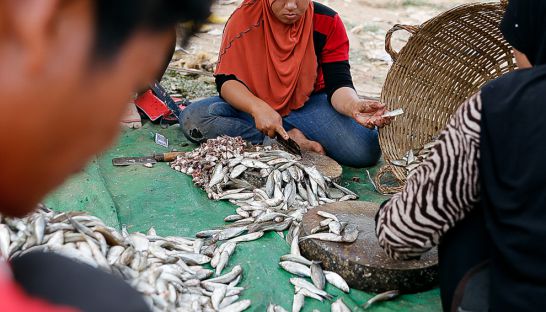Deeper water expected to yield more fish
Deeper water expected to yield more fish
Just weeks ahead of the main fishing season on the Tonle Sap river, which supplies the majority of the fish used in the Kingdom’s traditional cooking sauce, prahok, government officials are predicting a better catch this season as water levels have recovered from last year’s drought.

Eng Chea San, director-general of fisheries administration at the Ministry of Agriculture, said this year’s haul from capture fisheries should increase by 20,000 tonnes, while aquaculture yields could grow by up to 20 percent.
“We expect that the fish yield will increase compared to last year, as water levels are higher and stable,” he said yesterday.
Last year, Cambodian freshwater capture fisheries and aquaculture produced 751,000 tonnes of fish. The Tonle Sap river and lake contributed more than half of this total.
Fisheries administration official Ouch Vutha agreed that higher water levels this year were a good portend for the upcoming season, especially after a prolonged drought led to a precipitous drop in last year’s production.
“This year the river levels have risen, so we expect that the fish yield will be good for prahok,” he said.
In July, the government granted 92 dai, or bag net, permits for the Tonle Sap river. Vutha said the permits cover 14 river rows, a measurement used to make sure that the bag nets do not clog up river transport lanes and are placed to capture the flow of water. The primary fishing locations are in Phnom Penh, and in Kandal and Prey Veng provinces, he said.
Keo Vitou, chief of Ponhea Leu district fisheries administration in Kandal province, said fisherman have been preparing their nets since October, but the big catch is not expected until next month, and run until sometime in January. In Kandal province alone 10 rows have been set up with 42 dai permits.
“Some dai owners started collecting fish in October in order to make a profit, however the real profit is yet to begin as farmers wait for the next full moon cycle,” he explained, referring to the lunar phase that gives the best yields.
Vitou added that the government had closely monitored which areas to grant fishing permits and that the cost of the permit was based on the best seasonal locations.
Vitou said that last year, the fish yield in Kandal province was 5,200 tonnes, a 50 percent decline from 2014.
Loa Sreang, a dai owner in Kandal province who has been fishing on the Tonle Sap river for the last 10 years, said that he paid $5,000 and $18,000 to secure two locations along the river.
“I paid different prices in different locations because I am looking to collect the most fish,” he said. “If the season is good and the government continues to crack down on illegal fishing, I hope that I will make a good profit.”
He estimated that last year he lost around $20,000 during the peak prahok season due to the impact of the drought.













